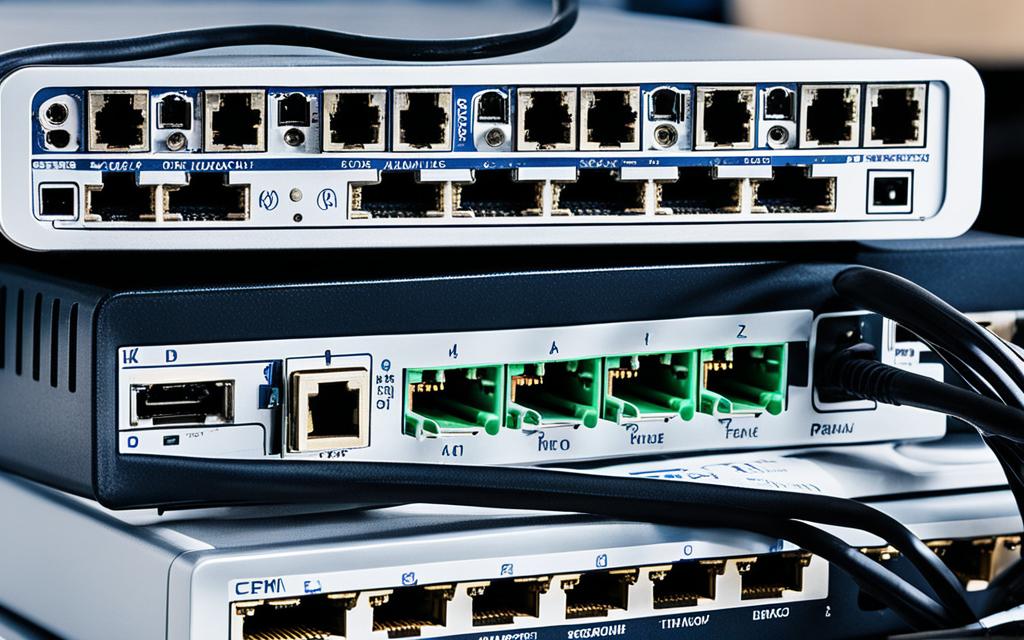Many devices can connect to the telephone network, making communication better and more connected. These devices have different roles and are key to setting up and keeping network connections strong. It’s important to know about these devices to build a modern, safe, and dependable network.
In the 1920s, the telephone network changed how we talk as more people got phones to share news and ideas1. The 1990s saw more changes with computers, advanced communication devices, and dial-up internet1.
There are different types of telephone networks like landline, wireless, private, and ISDN1. Public telephone operators manage these networks and offer services with government licenses1. Virtual Network Operators lease space from these operators and give phone services directly to people1.
Businesses have many phone system choices. Options include landlines, mobile networks, virtual phones, self-hosted VoIP, cloud-based VoIP, and hybrid systems2. Landlines are reliable but might not work well for employees who are often away from the office2. Mobile networks are good for small businesses with company phones2. Virtual phones are great for small businesses as they let you forward landlines to mobiles2.
Self-hosted VoIP is cheaper than landlines and needs little equipment2. Cloud-based VoIP is also cost-effective and can grow with your business, paid by subscription2. Hybrid systems link traditional phone networks to business IP-PBX systems, ideal for big companies2.
Since 2009, the use of traditional PSTN has been going down, and landlines are being used less3. Now, there are fewer fixed-line phone subscriptions than ever before, showing a drop in traditional PSTN use3. New tech like cloud phones and VoIP offers better and cheaper ways to communicate than PSTN3.
Key Takeaways
- Many devices connect to the telephone network, making communication better and more connected.
- Types of telephone networks include landline networks, wireless networks, private networks, and ISDN.
- Businesses have options like landlines, mobile networks, virtual phones, self-hosted VoIP, cloud-based VoIP, and hybrid systems.
- Traditional PSTN usage has been declining, leading to businesses adopting more efficient and cost-effective communication technologies.
Network Devices: Definition and Significance in Networking
Network devices are key to letting computers talk to each other and the internet. They help make connections, boost network speed, keep data safe, and make managing networks easier. These devices help send data, manage network traffic, add security, and fix signal problems.
In the 1990s, devices like bridges, hubs, NICs, modems, and repeaters were common. This shows how important they were back then4. As technology got better, DSL modems, leased line routers, WAPs, and firewalls became more popular, showing a move to new tech4.
Over time, networks got more secure. By 2010, using IDS and IPS, and VPN appliances was common4. This shows how networks started to use better security to protect data.
Switches are key for a fast network. Modular switches can change as networks grow or change4. Fixed switches are cheaper but can’t be changed4.
Managed switches let users control network settings like traffic and priorities4. Unmanaged switches are easy to set up and good for simple networks4.
Routers help guide network traffic. They use protocols like RIP, BGP, or OSPF to send data the right way4. These protocols help move data smoothly across networks.
Firewalls boost network security. Stateful firewalls check data for security by looking at IP addresses and ports4. Packet filtering firewalls check data packets by IP address and port4. Next-generation firewalls check the actual content of packets for better threat detection4.
Repeaters are important for wireless networks. They boost weak signals, making them stronger over longer distances4. This is especially useful in big places where Wi-Fi signals fade away.
Gateways connect networks that use different protocols. They help move data between networks and work like routers, making it possible for different networks to talk to each other4.
In conclusion, network devices are vital for today’s networks. They include switches, routers, firewalls, repeaters, and gateways, each with its own role. They improve network speed, security, and connectivity. Knowing about network devices is key to building strong and safe networks.
Types of Network Devices
Building a network involves various devices that are key for connectivity and communication. These devices have different roles and are classified by their functions and when they were introduced.
Let’s look at some early network devices:
- Bridges: At the Data Link layer, bridges link LAN segments together. They filter packets at the data link layer and increase a LAN’s capacity by joining multiple LANs5.
- Hubs: At the Physical layer, hubs boost the network’s coverage area and fix weak signals. They were used to connect many devices together.
- Network Interface Cards (NICs): These are hardware parts on computers that enable network connections.
- Modems: Modems work at the physical or Data link layer. They change analog carrier signals, allowing connections to the internet and home networks5.
- Repeaters: At the Physical layer, repeaters extend a network’s range and fix weak signals. They help increase a network’s coverage.
As networking tech got better, new devices came along. These include:
- Layer 2 Switches: These are the core of Ethernet networks6. They come in types like unmanaged, PoE, managed, Layer 3, and stackable switches6.
- Access Points (APs): APs are vital for wireless networks5. They boost wireless coverage and let more users connect5.
- Routers: Routers move packets between networks6. They work at the Network layer and help with internet and WAN connections6.
- Firewalls: Firewalls are key for network security. They come in types like packet-filtering, stateful-inspection, application, NGFWs, and UTM appliances6.
- Gateways: Gateways link networks with different protocols together. They can work at any OSI layer and connect before routing data5.
- Network-attached Storage (NAS): NAS is a file server in a LAN. It offers central storage, shared files, and backup services6.
- Load Balancers: Load balancers spread client connections across servers6.
Old and new network devices work together to make networks efficient and secure. They ensure data moves smoothly and devices connect well.
| Type of Device | Description |
|---|---|
| Bridges | Connect LAN cable segments together and facilitate packet filtering at the data link layer |
| Hubs | Expand the coverage area of the network and re-propagate weak or broken signals |
| Network Interface Cards (NICs) | Hardware components enabling connection to a network |
| Modems | Modulate and demodulate analog carrier signals, enabling connection to the internet provider’s connection and home network’s connection |
| Repeaters | Expand the coverage area of the network and re-propagate weak or broken signals |
| Layer 2 Switches | Basic building blocks of Ethernet networks with various types such as unmanaged switches, PoE switches, managed switches, Layer 3 switches, and stackable switches |
| Access Points (APs) | Create wireless local area networks (WLANs) and extend wireless coverage of existing networks |
| Routers | Route packets between networks, enabling communication between multiple subnets within the same WAN and internet connections |
| Firewalls | Restrict internet traffic for enhanced security, with different types such as packet-filtering firewalls, stateful-inspection firewalls, application firewalls, next-generation firewalls (NGFWs), and unified threat management (UTM) appliances |
| Gateways | Connect networks with varying transmission protocols and establish a connection before routing data |
| Network-attached Storage (NAS) | Serves as a dedicated file storage server in a LAN, providing central storage, shared file access, and backup facilities |
| Load Balancers | Distribute connections from clients across multiple servers |
Knowing about network devices is key for building and keeping networks efficient and secure. Each device has a special role in ensuring data flows well and devices connect smoothly.
With many network devices available, organizations can customize their networks to meet their needs and boost productivity.
Switches: Improving Network Efficiency
Switches are key devices that make networks run smoother and more reliably. They help direct traffic, boost performance, and reduce congestion. By smartly sending data to where it needs to go, they’re essential for today’s networks.
Switches keep track of network nodes, making connections efficient. They come in many types to fit different network needs.
According to statistical data7, Ethernet switches can have varying numbers of data ports, with a 24-port switch being a common example. This flexibility allows networks to expand and accommodate numerous devices.
Telephone networks use switches like PSTN Exchanges and PBXs for voice calls. These switches connect phone lines for clear communication.
Big companies often use PBX systems for calls within the company and to the PSTN. Smaller places might use Key Systems for similar tasks.
Statistics7 show that modern digital telecom switches use computers and electronics for quick call setup. They work with protocols like SS7 or SIP for VoIP, making communication efficient and reliable.
Old telephones needed operators to connect calls by hand. Now, technology has made this step automatic.
Switches are key to a fast network. They manage traffic well, making sure data gets to where it needs to go.
Packet switching is a big step up from old circuit switching. It’s faster, cheaper, and better for sending data. It’s great for small messages and is used a lot in networks.
Statistical data8 highlights packet switching’s role in modern WAN protocols like Frame Relay, X.25, and TCP/IP. It’s perfect for sending data that doesn’t mind a wait.
Switches have many features to make networks better. These include things like auto attendant and voicemail services.
A digital telecom switch has many parts like cabinets and handsets. These work together for smooth communication.
Advantages of Switches
| Advantage | Description |
|---|---|
| Improved Efficiency | Switches intelligently route and manage network traffic, minimizing congestion and optimizing performance. |
| Enhanced Security | Switches provide network segmentation and control access to enhance data security and protect against unauthorized access. |
| Increased Scalability | Switches can be easily expanded and upgraded to accommodate growing network demands. |
| Flexibility | Switches can be customized with different configurations to meet specific network requirements. |
Switches are vital for making networks better. They improve data flow, security, and connectivity. Their smart traffic management makes them a must-have in today’s networks.
Bridges: Connecting LANs and Filtering Frames
Bridges are key in networking, linking LANs and filtering frames to boost performance and security. Even though switches have taken over, bridges still have their place in networking.
Bridges make connecting LANs easy. They started in the 1980s and work at the Data Link Layer9. They connect different networks like Ethernet, Token Ring, and FDDI9, making communication possible across various technologies.
Bridges are great at reducing network congestion. They send packets only to where they need to go, not everywhere9. This cuts down on traffic and makes the network run smoother.
They also break up collision domains, reducing collisions on the network9. By doing this, bridges help keep the network stable and running well.
Bridges are experts at filtering frames. They use the IEEE 802.1 protocol to forward frames efficiently9. They learn which hosts can be reached through each interface9, making smart forwarding decisions based on hardware addresses.
Even though switches have become more common, bridges are still useful in certain situations. They’re great for network segmentation, extending networks, connecting different types of networks, wireless bridging, and adding redundancy9. Their flexibility makes them a good choice for specific networks.
Bridges offer many benefits like better network performance, security, design flexibility, and easy setup9. But, they also have some downsides. They can be less scalable, a single point of failure, less functional than routers and switches, and can be more expensive in some cases9.
In conclusion, bridges are still crucial in networking history. They help connect LANs and filter frames efficiently. Their role has shaped the modern network landscape.
Routers: Directing Traffic and Dividing Networks
Routers are key in computer networking. They help move data between different networks. They look at incoming packets, figure out where they need to go, and send them there. This makes sure data moves smoothly by breaking networks into smaller parts.
Routers use destination IP addresses to send traffic between networks. They use protocols like BGP and OSPF to share info with other routers. This helps them find the best way to send data10.
Routers work at Layer 3 of the TCP/IP model. This layer is all about moving traffic between networks. They act as gateways, connecting different networks with their own IP addresses10.
With SDN, routers have become more flexible and scalable. SDN lets them manage networks better and adapt to changes easily10.
The Internet of Things (IoT) has made networks busier. Routers are now more important for handling this traffic and keeping devices connected10.
Security is a big concern in networking, and routers help with this. They use protocols and filters to keep networks safe from threats10.
Cloud computing has made it important for routers to communicate well with virtual machines. They make sure data moves smoothly in the cloud10.
Routers vs. Switches: Different Functions, Same Goal
Routers and switches are both important for networks, but they do different jobs. Routers manage traffic between networks, while switches work within a network. They send data to the right devices using MAC addresses10.
Routers connect networks together, letting data go across different networks. They use IP addresses to send data to where it needs to go. This way, routers and switches work together to make sure data moves well10.
| Types of Routers | Description |
|---|---|
| Core Routers | These routers handle the routing of data packets within a network. They are responsible for efficiently forwarding packets between devices within the network, ensuring smooth communication. |
| Edge Routers | Edge routers connect internal networks to external networks, such as the internet. They employ the Border Gateway Protocol (BGP) for connectivity, ensuring reliable and secure communication with external networks. |
| Wireless Routers | Wireless routers provide Wi-Fi connectivity, allowing devices to connect to a network without the need for physical cables. They typically have an indoor range of 150 feet and an outdoor range of 300 feet. |
| Broadband Routers | Broadband routers are specifically designed for high-speed internet access. They incorporate Voice over IP (VoIP) technology, enabling voice and multimedia communication over the internet. |
| Brouters | Brouters are specialized routers that can also perform bridge functions. They aid in the transit of data between networks, combining the functions of both routers and bridges. |
Routers work on several layers of the OSI model. This lets them handle tasks like breaking data into smaller pieces. This ensures data moves smoothly between networks of different sizes11.
Routing protocols are key for finding the best paths in a network. There are static and dynamic types. Static needs manual setup, while dynamic updates automatically10.
Distance Vector Protocols update routing tables at set times. This keeps all routers informed about network changes12.
Protocols like RIP and IGP help networks route data efficiently. They make sure data moves well, keeping networks running smoothly12.
Routing tables in routers keep track of all possible routes. They update often to keep data moving fast and efficiently11.
Routers are vital for modern networks. They make sure data moves well, keep networks safe, and adapt to new trends like SDN, IoT, and cloud computing10.
Firewalls: Restricting Internet Traffic for Enhanced Security
Firewalls are key in keeping networks safe by restricting internet traffic. They check and control data packets to keep out unwanted access and block harmful traffic. This makes networks more secure.
Since the late 1980s, firewalls have grown and changed to meet new threats13. They’ve moved from simple packet filters to advanced Next-Generation Firewalls. These new firewalls fight against today’s complex cyber threats.
The 1980s saw the start of Generation 1 viruses, affecting many businesses13. To fight back, companies used firewalls to protect their networks from Generation 2 attacks in the mid-1990s13.
By the early 2000s, Generation 3 attacks targeted apps, leading to the creation of Intrusion Prevention Systems13. By 2010, Generation 4 attacks brought new threats, making anti-bot and sandboxing products necessary13.
Recently, Generation 5 attacks have become more complex, pushing for better threat prevention. Next Generation Firewalls have become vital for network security. They offer network threat prevention, application and identity-based control, hybrid cloud support, and scalable performance13.
Types of Firewalls
Firewalls come in different types, each with unique features. Some common types include:
- Packet filtering firewalls: These firewalls look at a bit of data and decide where to send it, based on things like IP addresses and ports13.
- Proxy service firewalls: These firewalls check messages at the application level for better security. They look at whole network packets, not just basic details. But, this can slow things down because it makes more connections for each packet1314.
- Stateful inspection firewalls: These firewalls keep an eye on active connections. They decide to allow or block network packets based on the connection’s state. This gives a higher level of protection by looking at the context of data packets13.
- Next Generation Firewalls: These advanced firewalls do deep packet inspection at the application level. They can spot and stop complex threats. They offer many layers of security and react fast to threats13.
Next Generation Firewalls are key in stopping malware and application-layer attacks. They keep networks safe. They handle things like Network Address Translation (NAT) and Virtual Private Networks (VPNs). They also include Unified Threat Management (UTM) devices and sandboxing technologies for better threat prevention1314.
Check Point’s Quantum NGFW is a top example of a Next Generation Firewall. It offers AI-powered threat prevention, seamless scalability, and unified policy management for top-level security. It has advanced features to fight a wide range of cyber threats13.
Firewalls: A Line of Defense
Firewalls act as a defense against many cybersecurity threats. They stop remote login attacks, denial of service (DoS) attacks, email bombing, macros attacks, and virus infections1314. With the right setup, firewalls set strict security rules for devices on the internet, keeping data safe14.
In today’s connected world, firewalls are crucial for protecting networks and keeping customer trust. By using strong firewall solutions, businesses can keep data private, stop unauthorized access, and stay ahead in handling sensitive information15.
Firewall Services for Businesses
Companies like Kirbtech help businesses pick and set up the right business firewall solutions. They offer IT solutions that fit specific industries or markets well. Working with experts ensures networks stay safe in today’s changing threat landscape15.
Repeaters: Strengthening Signals for Extended Range
Repeaters are key in boosting network performance by making signals stronger and covering more distance16. They’re used in many areas like telecommunications and radio communications. They help improve signal quality and reduce data loss, making signals stronger and reaching further16.
Using a repeater has many benefits16. They make signals go further, improve quality, and cover more area16. This means less data loss and a smoother experience for users16. They’re also affordable, flexible, and easy to add to different setups16.
But, repeaters have their downsides16. They can’t cover as much distance and signal quality may drop with each retransmission16. They can also cause delays and add to interference16. Plus, they have limited capacity and can be tricky to set up, with a single point of failure16.
For wireless networks, WiFi repeaters are crucial16. They take the WiFi signal, boost it, and send it out again to devices, extending the network’s reach16. They connect devices to the router, ensuring a strong signal everywhere16.
It’s important to know the difference between WiFi extenders and repeaters16. Extenders create a new network name and password, while repeaters just make the existing network go further without a new name16. This lets devices stay connected as they move around16.
Routers connect devices to the internet, while repeaters extend wireless signals16. So, repeaters are perfect for when you just need to cover more ground16.
You can turn a WiFi router into a repeater if it supports it16. This is a budget-friendly way to grow your network without buying more gear16.
But, using repeaters without permission can lead to trouble16. It can mess with other networks and get you in legal trouble16. Always get the okay and follow the rules when using repeaters16.
| Benefits of Repeaters | Limitations of Repeaters |
|---|---|
“Repeaters are invaluable in extending network coverage and improving signal strength. By overcoming obstacles and amplifying signals, these devices ensure reliable communication and enhanced user experiences.”
– Telecom expert16
Gateways: Connecting Networks with Different Protocols
Gateways are key in linking networks with different protocols for smooth communication.
They make internet access easier by combining many devices into one. This cuts down on setup complexity and lowers costs17.
Gateways also offer various features for specific network needs. For example, in businesses, they can act as proxy servers and firewalls. This ensures safe and controlled access to the internet17.
They help networks with different protocols talk to each other. This makes sharing information between networks easier, promoting teamwork and sharing17.
There are many types of gateways, each with its own job. Some are for web security, cloud storage, or IoT devices. Others are for email, VoIP, or media17.
Service providers create custom gateways for different customer needs. This improves how networks work together and boosts performance17.
Amazon Web Services (AWS) has its own gateway. It helps connect non-AWS apps with AWS services smoothly17.
Routers connect similar networks, while gateways link different ones. Routers keep data within networks, and gateways make sure different networks talk to each other17.
In homes or businesses, routers are key for internet access. They let users get to online services and resources17.
Gateways are vital in IoT and cloud settings. They let devices with different protocols work together smoothly. They connect IoT devices, the cloud, and devices like smartphones for easy communication and data sharing18.
In IoT, various protocols help devices work together. These include DDS, REST, and XMPP, and broker-based protocols like AMQP and MQTT. These protocols help devices talk to each other without overloading their resources18.
IoT developers use languages like C, Java, Python, or scripting for IoT nodes. Gateways then convert protocols, manage databases, and make decisions, making the system smarter and more efficient18.
Gateways are not just for IoT. They can also connect private cloud storage to apps, making data access easy without moving to a public cloud18.
Email security gateways protect business emails from harmful content. They keep users and networks safe19.
VoIP trunk gateways link traditional phones to VoIP networks. This offers affordable phone services without needing human operators19.
Web application firewalls create secure paths between clients and servers. They protect networks from cyber threats19.
In short, gateways are key for connecting networks with different protocols. They ensure smooth communication and offer many benefits. Whether in IoT, cloud, or business networks, gateways are essential for connectivity and efficient communication171819.
Modems: Modulating Signals for Internet Access
Modems are key in the world of networking, making internet access possible. They change signals between analog and digital formats. This lets devices and the internet talk to each other. Modems connect homes, businesses, and other places to the internet.
Internet modems take signals from an Internet Service Provider (ISP) and change them for devices to use. This makes it possible for devices to understand and use the internet’s digital data. Modems bridge the gap between the internet’s digital signals and the analog signals over phone lines or cables.
The evolution of modems is amazing20. In the 1970s, modems were slow, working at 110 or 300 bits per second20. By the 1980s, they got faster, reaching speeds of 1,200 to 2,400 bits per second. Today, modems can go from tens to hundreds of megabytes per second, making online activities smooth and fast20.
In 1981, the Hayes Smartmodem changed the game20. It introduced a command language for better control over data connections. This made modems work more efficiently with computers. The success of the Smartmodem led to more innovations in modem technology.
Another big step was in 1982 with the Commodore VicModem20. It was the first modem under $100 and sold over a million units. This made modems more affordable for everyone, spreading internet access wider.
Modems use different ways to connect, like Ethernet, DSL, or fiber optics20. They usually connect to routers to give internet access to devices. The modem gets signals from the ISP and sends them to devices, linking the internet to our local networks.
For more info on modems, check out these sources:
- Learn more about modems on Wikipedia and explore their history, functions, and types.
- For a detailed glossary of modem terms, visit Lenovo.com.
- See GeeksforGeeks for insights into modems, their types, and how they work.
Key Insights
| Insight | Statistical Data21 |
|---|---|
| Modems can connect a specific number of devices to the internet. | Modems can connect only a specific number of devices to the internet21. |
| The price range of modems varies according to their features. | The price range of modems varies according to their features21. |
| Modems slow down their processes when connected to a hub. | Modems slow down their processes when connected to a hub21. |
| Dial Modems transmit data at a speed of 56,000 per/sec. | Dial Modems transmit data at a speed of 56,000 per/sec21. |
| Optical Modems use optical cables for data transmission. | Optical Modems use optical cables for data transmission21. |
| Digital Modems convert digital data into digital signals by modulation. | Digital Modems convert digital data into digital signals by modulation21. |
| Cable Modems establish communication between computer systems and Internet Service Providers for high-speed data access. | Cable Modems establish communication between computer systems and Internet Service Providers for high-speed data access21. |
| Satellite Modems provide internet connections through satellite dishes for reliable and efficient networking. | Satellite Modems provide internet connections through satellite dishes for reliable and efficient networking21. |
| Modems increase in cost based on the features they offer. | Modems increase in cost based on the features they offer21. |
| Modems help connect LAN to the internet. | Modems help connect LAN to the internet21. |
| Modems do not provide maintenance of traffic. | Modems do not provide maintenance of traffic21. |
| Modems have a high risk of security-related attacks. | Modems have a high risk of security-related attacks21. |
| Standard modems can be internal or external and make use of generic device drivers. | Standard modems can be internal or external and make use of generic device drivers21. |
| Computer systems cannot directly communicate with ISPs but require a modem for connection. | Computer systems cannot directly communicate with ISPs but require a modem for connection21. |
| The main difference between a modem and a router is that the modem receives internet signals from the provider, while the router transmits signals to network devices. | The main difference between a modem and a router is that the modem receives internet signals from the provider, while the router transmits signals to network devices21. |
| A switched telephone network or a dedicated circuit can be used as a transmission medium between two different modems. | A switched telephone network or a dedicated circuit can be used as a transmission medium between two different modems21. |
Modems are key to internet connectivity, connecting us to the internet. They change signals to make them usable. From slow dial-up to fast broadband, modems have shaped the internet. As technology grows, modems will keep helping us explore and connect online.
Conclusion
Devices like switches, routers, firewalls, and modems are key to better communication and connectivity today. They each have a special job in making and keeping network connections strong.
With over 307,000 cell towers in the U.S., coverage is wide22. Verizon leads with 70% 4G coverage. Soon, 5G will change the game with speeds up to 20 Gbps.
Old phone networks are giving way to new ones like VoIP and SIP trunking23. These new systems are cheaper, faster, and offer more features. Businesses are switching for these benefits.
Cell phones have come a long way from analog to digital24. Now, people can use their phones for calls and data anywhere, even in the countryside.
FAQ
What are network devices?
Network devices help computers talk to the internet. They are either hardware or software.
What functions do network devices serve?
These devices are key for making networks work better. They help send data, keep connections safe, manage traffic, and more. They also make networks secure, easy to set up, and fix signal problems.
What are the types of network devices?
There are many, like bridges, hubs, NICs, modems, and more. You’ll also find repeaters, DSL modems, routers, WAPs, firewalls, IDS, IPS, and VPN appliances.
How do switches improve network efficiency?
Switches connect many devices efficiently. They keep track of network nodes for better connections. This makes networks run smoother, safer, and faster.
What is the role of bridges in a network?
Bridges link different networks or segments together. They check data frames by MAC address and send them where they need to go.
How do routers direct network traffic?
Routers look at incoming packets and send them to their destinations. They split networks into smaller parts and keep track of where data goes.
What is the purpose of firewalls?
Firewalls control internet traffic for safety. They check data packets against rules to block unwanted traffic. This keeps networks safe from unauthorized access.
How do repeaters enhance signal coverage?
Repeaters boost and resend signals to reach farther. They fight against signal loss and interference. Repeaters help with wireless networks, fiber optics, phones, and TV.
What do gateways do in a network?
Gateways connect different networks or systems. They change data packets so they can move between networks. This is key for IoT and cloud connections.
How do modems facilitate internet access?
Modems change signals between analog and digital. Internet modems get signals from ISPs and turn them into something devices can use. They connect through Ethernet, DSL, fiber, or wireless.
Why is understanding network devices important?
Knowing about network devices is key for a secure, reliable network. It helps build a modern network that works well.
Source Links
- https://en.wikipedia.org/wiki/Telephone_network – Telephone network
- https://www.net2phone.com/blog/types-of-phone-systems – Types Of Phone Systems For Business | net2phone
- https://www.nextiva.com/blog/what-is-pstn.html – What Is PSTN and How Does It Work?
- https://blog.netwrix.com/2019/01/08/network-devices-explained/ – Network Devices: Types, Functions and Best Practices for Security Management
- https://www.nwkings.com/network-devices – Top 11 Network Devices in Networking and its Types
- https://www.auvik.com/franklyit/blog/network-devices/ – What Are the Types of Network Devices?
- https://www.spectrumvoip.com/network-switch-pbx/ – What is a Switch? | SpectrumVoIP
- https://avinetworks.com/glossary/packet-switching/ – What is Packet Switching? Definition & FAQs | Avi Networks
- https://www.geeksforgeeks.org/bridges-local-internetworking-device/ – Bridges (local Internetworking device) – GeeksforGeeks
- https://erieit.edu/introductory-guide-routing-switching/ – An Introductory Guide to Routing & Switching
- https://stl.tech/blog/what-are-routers-in-networking/ – What are Routers in Networking? – STL Tech
- https://superuser.com/questions/1781245/how-routing-works-on-internet – How routing works on Internet
- https://www.checkpoint.com/cyber-hub/network-security/what-is-firewall/ – What is a Firewall? The Different Types of Firewalls – Check Point Software
- https://www.hp.com/us-en/shop/tech-takes/what-is-a-network-firewall – What Is A Network Firewall And How Does It Work | HP® Tech Takes
- https://kirbtech.com/benefits-of-firewalls/ – Why Are Firewalls Important? | Network Firewall Security
- https://www.sannytelecom.com/what-is-a-repeater/ – What Is A Repeater? – Sanny Telecom
- https://www.techtarget.com/iotagenda/definition/gateway – What is a Gateway? Definition from WhatIs.com
- https://en.wikipedia.org/wiki/Gateway_(telecommunications) – Gateway (telecommunications)
- https://stl.tech/blog/role-of-gateways-in-a-computer-network/ – Role of Gateways in a Computer Network | STL
- https://en.wikipedia.org/wiki/Modem – Modem
- https://www.geeksforgeeks.org/what-is-modem/ – What is Modem? – GeeksforGeeks
- https://millmanland.com/knowledge/what-is-a-cell-tower-and-how-does-a-cell-tower-work/ – What Is a Cell Tower and How Does a Cell Tower Work? | Millman National Land Services
- https://blog.ultatel.com/pstn-guide – PSTN: The Definitive Guide to Understand Public Switched Telephone Networks – ULTATEL Blog
- https://www.sciencedirect.com/topics/physics-and-astronomy/telephone-network – Telephone Network – an overview



















